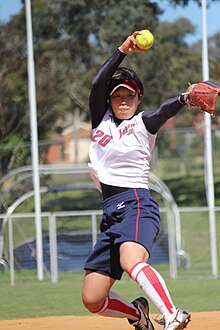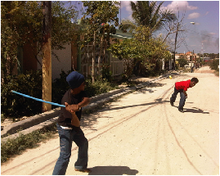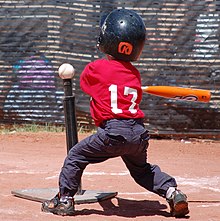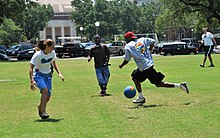Variations of baseball

Baseball is a bat-and-ball sport that has many recreational variants (sometimes referred to as diamond sports),[1] and is very related to the Olympic discipline of softball,[2] with the two sports being administered internationally alongside Baseball5 (invented in 2018) by the World Baseball Softball Confederation.[3]
Many variations of baseball change the game significantly. For example, many variations are played informally, with less equipment/space requirements and a softer ball, and certain variations do not feature a pitcher, and/or have the batters hit the ball using their hands or feet,[4][5] with failure to legally hit the ball resulting in an automatic out.[6] There may be a lack of baserunning, with base hits awarded according to the distance or number of bounces the batted ball takes before being fielded, and imaginary "ghost runners" advancing around the bases in lieu of actual runners.[7][8] Other variations are more loosely based on baseball, often involving the same scoring system applied to dramatically different contexts, such as playing darts.[9]
There are also some bat-and-ball sports which are distinct from baseball, such as rounders, that strongly resemble it.[10]
Olympic sports[]
Softball[]
Softball originated as a variation of baseball,[11] and today is a very popular sport in its own right,[12] with most of the rules remaining the same as baseball. The field is significantly smaller, with the bases only 60 feet (18 m) apart, and the pitcher is required to throw the ball underarm throughout the seven regulation innings of play.[13] Softball is administered at the international level along with baseball by the World Baseball Softball Confederation, with the two sports being treated as disciplines of the same overall sport when played at the Olympics.[14] Alongside the Olympic discipline of fastpitch softball, which is the most popular variation of softball, there is also modified fastpitch softball and slow-pitch softball.[15]
Baseball5[]

Baseball5 (B5) is an international variation of baseball where the only equipment used is a rubber ball, and the field is a 21 m (69 ft)-square.[4][16] Batters "self-serve" the ball, hitting it with a bare hand to start each play, with foul balls and out-of-the-park home runs not permitted.[6][17] Each team has only five players and there are five innings in the game.[18] It is scheduled to be played at the 2026 Youth Olympic Games, and is administered by the World Baseball Softball Confederation.[19]
Informal variations[]

These variations of baseball generally reduce the amount of equipment and space needed to play the game, and the ball is often softer to reduce the risk of injury.[5] They may also be modified to work with fewer players; for example, some informal variations of baseball use the ghost runner rule, simulating having runners on base when a player must take their turn to bat.[7] However, the basic structure of a pitcher throwing to a batter, with the batter hitting the ball with some type of bat, is retained.
Stickball[]
In stickball, the bat is a broom handle, and the ball is generally a rubber ball or tennis ball. It is generally played as a street game.[20]
Vitilla[]
Vitilla is a variation of stickball played mostly in the Dominican Republic. Instead of a ball, a large plastic water bottle cap is thrown towards the batter, and there are only two bases to advance around before going to home plate. In addition, the strike zone is represented by a physical object behind the batter.[21]
Wiffle ball[]
Wiffle ball is played with a plastic bat and ball. The ball is designed to have more movement in the air, so that pitchers can more easily trick batters with different types of pitches.[22]
Corkball[]
Corkball does not feature baserunning: the value of a hit is measured by the distance traveled by the batted ball. The advancement of ghost runners placed on base is how runs are scored.[7]
Games with no pitcher[]

The following variations of baseball do not have a pitcher, meaning that the batter starts every play with possession of the ball. They may feature strikes, or the batter may automatically be out for failing to legally hit the ball into fair territory.[6]
Tee-ball[]
Tee-ball is a popular introductory variant of baseball for children, with the ball placed on a "batting tee" each time a batter is prepared to hit. The batter hits the ball off the tee to commence play.[23] Older players may be given the opportunity to face some pitches from their coach, making it easier for them to hit the ball while still helping them to progress toward facing an opposing pitcher. Each inning may be played until three outs, or until all players on the offensive team have had a turn to bat.[24]
Games with no bat[]
The following games involve the use of either the hands or the legs in order to hit the ball.
Kickball[]

Kickball is a popular variation of baseball, which involves batters kicking the ball with their legs. The ball is thrown underhand by the pitcher, and must roll to the batter.[25][26]
Matball[]
Matball, also known as Big Base, is a variation of kickball where multiple runners can be on a base, with the bases being large mats.[27]
Punchball[]
Punchball/slapball is played with the hands: batters start each play off by hitting the ball into play using their bare hands. There is no pitcher.[28]
Unorthodox variations[]
Over-the-line[]

Over-the-line (OTL) is a variation requiring only three players per team, and is played without gloves in some gender/age divisions. The batter stands at the point of a triangle, with his goal being to hit the ball (pitched by a teammate) over the opposing line of the triangle without the ball being caught by a defender. The fair territory is designated by two parallel lines emanating at right angles from the two corners of the triangle away from the batter. There is no baserunning, with runs scored when there are either 3+ "base hits" (uncaught fair balls) in an inning, or a "home run" (a ball landing past the furthest fielder).[29]
Stoop ball[]
Stoop ball is a variation where the ball is thrown by the batter at the steps of a stoop (concrete stairway) with the goal of making the rebounded ball travel away from the fielders. Bases or points are awarded based generally on the distance or number of bounces the ball takes before it is fielded.[8]
Beep baseball[]
Beep baseball is generally played by visually impaired or blind players, using a ball that beeps so that it can be located more easily. There are "spotters" who assist the fielders by indicating which section of the field the batted ball has been hit into.[30] The game is played to six innings.
Dartball[]
Dartball is played using a dartboard, with the results of each throw of the dart relating to the rules of baseball. "Batters" simulate an at-bat, with the dart's landing position on the board determining whether they get a ball or strike, and whether they ultimately reach base/advance runners already on base.[9]
Related bat-and-ball sports[]
Pesäpallo[]

Pesäpallo, also known as Finnish baseball, was invented in the 1920s, with some of it being based on baseball.[31] It has four bases placed at increasing distances between each other (such that the distance between 3rd base and home is greater than between home and 1st base.) The ball is pitched "vertically" to the batter (such that it is thrown upwards by the opposing pitcher at home base), and is hit as it lands. The game features a number of significant differences to baseball: it is not possible to hit out-of-the-park home runs, as these are considered foul balls, and batters do not have to run on fair contact, being allowed three chances to hit the ball (regardless of the result of each hit) before being forced.[32]
Rounders[]
Rounders involves a similar hitting of a thrown ball as baseball, with a "rounder" being scored upon rounding all four bases. There is no foul territory, so that the ball can be hit in any direction. It is popular in the United Kingdom among school children, having been played since the 1700s.[10][33]
See also[]
References[]
- ^ "Australian baseball, softball governing bodies backing 2028, 2032 Olympic push". wbsc.org. Retrieved 2021-10-09.
- ^ "The Differences between Softball and Baseball". dummies. Retrieved 2021-09-22.
- ^ "WBSC Organisational Profile". wbsc.org. Retrieved 2021-10-11.
{{cite web}}: CS1 maint: url-status (link) - ^ a b "WBSC approves esports and Baseball5 as disciplines of baseball and softball". www.insidethegames.biz. 11 December 2020. Retrieved 2021-09-06.
{{cite web}}: CS1 maint: url-status (link) - ^ a b "Streetplay.com: Stickball Basics". www.streetplay.com. Retrieved 2021-09-22.
- ^ a b c Baseball5 Rulebook 2021 "In Baseball5, unlike in baseball and softball, it is the first bounce of the ball that determines whether the hit ball is fair or not: • First bounce in foul territory = batter is OUT"
- ^ a b c Brett and Kate McKay (2021-05-06). "Corkball: The Mutant Baseball Game That's a St. Louis Tradition". The Art of Manliness. Retrieved 2021-09-08.
- ^ a b "NYCdata | Uniquely NYC". www.baruch.cuny.edu. Retrieved 2021-09-21.
- ^ a b "Dartball". www.darts501.com. Retrieved 2021-09-09.
- ^ a b "Baseball Discovered: Rules of the Game: Rounders". Major League Baseball. Retrieved 2021-09-08.
- ^ "softball | Definition, Rules, History, & Facts". Encyclopedia Britannica. Retrieved 2021-09-08.
- ^ "Softball's international success unites players and fans". Athletes Unlimited. 2020-07-13. Retrieved 2021-09-06.
- ^ "Are Softball Rules The Same As Baseball?". www.rookieroad.com. Retrieved 2021-09-06.
- ^ Rosenberg, Benjamin. "Players Pay No Mind To Olympic Softball On Baseball Field". www.softballamerica.com. Retrieved 2021-09-06.
The International Olympic Committee considers baseball and softball to be a single sport
{{cite web}}: CS1 maint: url-status (link) - ^ "History". www.softball.org.nz. Retrieved 2021-09-23.
- ^ Baseball5 Rulebook 2021Pg. 3 "THE FIELD"
- ^ BaseballSA - Baseball5 Live Showcase - Round 2 | Facebook, retrieved 2021-10-11,
Timestamp is 3:20
- ^ "WBSC enters partnership with Mondo to showcase Baseball5 at Paralympics fan park". www.insidethegames.biz. 25 August 2021. Retrieved 2021-09-06.
{{cite web}}: CS1 maint: url-status (link) - ^ "High five: baseball5 hits the YOG". Olympics.com. Retrieved 2021-09-08.
- ^ "Stickball | game". Encyclopedia Britannica. Retrieved 2021-09-08.
- ^ "The Clasico De Vitilla: A stickball-style tournament that just might be harder than baseball". MLB.com. Retrieved 2021-09-08.
- ^ "A Brief History of Wiffle Ball". www.mentalfloss.com. 2014-06-29. Retrieved 2021-09-08.
- ^ "Tee-Ball Rules Rules: How To Play Tee-Ball | Rules of Sport". www.rulesofsport.com. Retrieved 2021-09-06.
- ^ "Everything You Need To Know About Tee Ball Rules". Fatherly. 2018-05-22. Retrieved 2021-09-06.
- ^ "History Of Kickball". www.rookieroad.com. Retrieved 2021-09-06.
- ^ "Kickball". Playworks. Retrieved 2021-09-06.
- ^ Update, Physical Education (2010-07-27). "Games: Matball Variations". Retrieved 2021-09-22.
- ^ Shapiro, Ralph (September 2012). From NYC Lower East Side To NASA Satellite Operations Manager. Xlibris Corporation. ISBN 978-1-4797-0409-5.
- ^ "How to Play Over-the-Line Baseball". SportsRec. Retrieved 2021-10-12.
- ^ "Beep baseball brings the competition of sports to the blind". MLB.com. Retrieved 2021-09-06.
{{cite web}}: CS1 maint: url-status (link) - ^ "In English". Pesäpalloliitto (in Finnish). Retrieved 2021-09-21.
- ^ Costa, Brian (2015-07-09). "What Finland Can Teach America About Baseball". Wall Street Journal. ISSN 0099-9660. Retrieved 2021-09-21.
- ^ "Rounders | English game". Encyclopedia Britannica. Retrieved 2021-09-21.
External links[]
- Australia Baseball5 Training Manual - features a number of training games and variations of Baseball5
This article needs additional or more specific categories. (December 2021) |
- Baseball genres